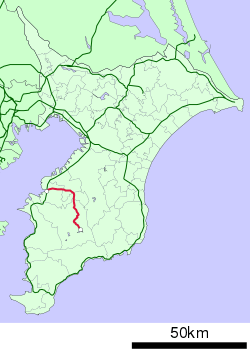Kururi Line
The Kururi Line (久留里線, Kururi-sen) is a railway line in Chiba Prefecture, Japan, operated by the East Japan Railway Company (JR East). It connects Kisarazu Station in Kisarazu to Kazusa-Kameyama Station in Kimitsu. The railway route extends through three cities, Kimitsu, Kisarazu, and Sodegaura. It has no double-track section, and trains can pass at only two stations, Yokota Station and Kururi Station.
| Kururi Line | |||
|---|---|---|---|
Kururi Line E130 series DMUs | |||
| Overview | |||
| Locale | Chiba Prefecture | ||
| Termini | Kisarazu Kazusa-Kameyama | ||
| Stations | 14 | ||
| Operation | |||
| Opened | 1912 | ||
| Operator(s) | JR East | ||
| Depot(s) | Kisarazu | ||
| Rolling stock | KiHa E130 series | ||
| Technical | |||
| Line length | 32.2 km (20.0 mi) | ||
| Number of tracks | 1 | ||
| Track gauge | 1,067 mm (3 ft 6 in) | ||
| Electrification | None | ||
| Operating speed | 65 km/h (40 mph) | ||
| |||
| Route diagram | |||||||||||||||||||||||||||||||||||||||||||||||||||||||||||||||||||||||||||||||||||||||||||||||||||||||||||||||||||||||||||||||||||||||||||||||||||||||||||||||||||||||||||||||||||||
|---|---|---|---|---|---|---|---|---|---|---|---|---|---|---|---|---|---|---|---|---|---|---|---|---|---|---|---|---|---|---|---|---|---|---|---|---|---|---|---|---|---|---|---|---|---|---|---|---|---|---|---|---|---|---|---|---|---|---|---|---|---|---|---|---|---|---|---|---|---|---|---|---|---|---|---|---|---|---|---|---|---|---|---|---|---|---|---|---|---|---|---|---|---|---|---|---|---|---|---|---|---|---|---|---|---|---|---|---|---|---|---|---|---|---|---|---|---|---|---|---|---|---|---|---|---|---|---|---|---|---|---|---|---|---|---|---|---|---|---|---|---|---|---|---|---|---|---|---|---|---|---|---|---|---|---|---|---|---|---|---|---|---|---|---|---|---|---|---|---|---|---|---|---|---|---|---|---|---|---|---|---|
| |||||||||||||||||||||||||||||||||||||||||||||||||||||||||||||||||||||||||||||||||||||||||||||||||||||||||||||||||||||||||||||||||||||||||||||||||||||||||||||||||||||||||||||||||||||
Stations
| Station | Japanese | Distance (km) |
Transfers | Location | |
|---|---|---|---|---|---|
| Kisarazu | 木更津 | 0.0 | Uchibō Line | Kisarazu | Chiba Prefecture |
| Gion | 祇園 | 2.6 | |||
| Kazusa-Kiyokawa | 上総清川 | 4.2 | |||
| Higashi-Kiyokawa | 東清川 | 6.1 | |||
| Yokota | 横田 | 9.3 | Sodegaura | ||
| Higashi-Yokota | 東横田 | 10.8 | |||
| Makuta | 馬来田 | 13.9 | Kisarazu | ||
| Shimogōri | 下郡 | 15.2 | Kimitsu | ||
| Obitsu | 小櫃 | 18.2 | |||
| Tawarada | 俵田 | 20.0 | |||
| Kururi | 久留里 | 22.6 | |||
| Hirayama | 平山 | 25.7 | |||
| Kazusa-Matsuoka | 上総松丘 | 28.3 | |||
| Kazusa-Kameyama | 上総亀山 | 32.2 | |||
Rolling stock
- KiHa E130-100 series DMU cars x10 (from 1 December 2012)[1]
Former rolling stock
- KiHa 30 DMU
- KiHa 37 DMU
- KiHa 38 DMU
History
The Chiba Prefectural Government opened the 762 mm (2 ft 6 in) gauge section from Kisarazu to Kururi as a light railway on 28 December 1912.
In 1922, the Railway Construction Act was amended by the Diet, and a new rail line connecting Kisarazu Station to Ōhara Station on the Sotobō Line via Kururi and Ōtaki, to transect the Bōsō Peninsula, appeared on the list as compensation for the underdeveloped network of roads in the area at that time.
On 1 September 1923, the Kisarazu to Kururi Line was nationalised, and the line was named the Kururi Line under the Japanese Government Railways (JGR) system. On 20 August 1930, the track gauge was widened to 1,067 mm (3 ft 6 in), and on 25 March 1936, the line was extended to Kazusa-Kameyama Station.
The private Kihara Line from Ōhara Station was extended to Kazusa-Nakano Station in 1934, and it was planned that the Kururi Line and the Kihara Line would be connected to form a single route across the Bōsō Peninsula (which would have been named the Kihara Line). However, due to World War II, the plan was abandoned, and Kururi Line was never to be extended into the most mountainous area of the peninsula. Services on the section from Kururi Station to Kazusa-Kameyama Station were suspended from 1944 to 1947.
New KiHa E130-100 series DMU trains are scheduled to be introduced from 1 December 2012, replacing the ageing KiHa 30/37/38 DMUs.[1]
References
| Wikimedia Commons has media related to Kururi Line. |
- 久留里線旧型気動車さよなら記念イベント [Old Kururi Line diesel train farewell event] (PDF). News release (in Japanese). Japan: East Japan Railway Company Chiba Division. 21 September 2012. Retrieved 25 September 2012.

.svg.png)